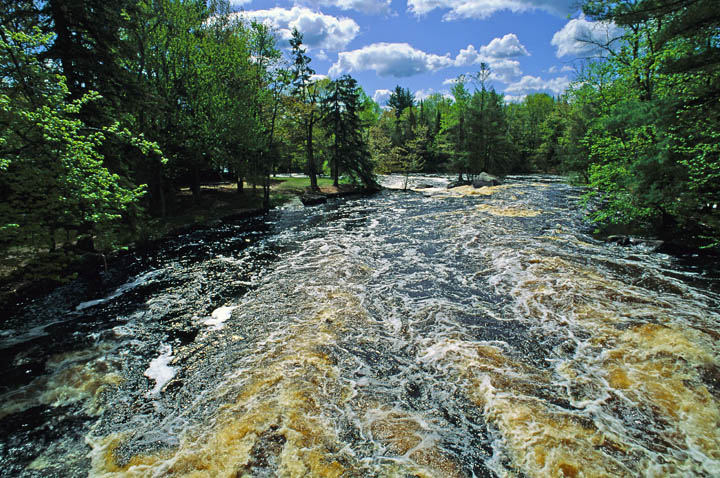
American forests tower in US economy
Forest Service lands continue to be a value that attracted 165.7 million visitors in 2011, and that visitor spending in nearby communities sustained more than 200,000 full- and part-time jobs.Restoration and fuel thinning efforts contributed $21 million to local economies, producing 121 million board feet of lumber and 267,000 tons of woody biomass for bio-energy production.
August 8, 2012

The USDA highlighted how our nation's forests are contributing billions of dollars to the economy and creating jobs through tourism, restoration, and renewable energy initiatives. The U.S. Forest Service released its annual visitor survey which showed Forest Service lands attracted 166 million visitors in 2011, and that visitor spending in nearby communities sustained more than 200,000 full- and part-time jobs. The Forest Service also announced that restoration efforts contributed $21 million to local economies and reduced fire threats on 123,000 acres of land nationwide.
Additionally, the Forest Service announced an award of $4 million for wood-to-energy projects and the opening of a first of its kind, $1.7 million nanocellulose lab. The lab will support an emerging market for new wood-derived renewable materials that will create jobs and contribute billions of dollars to the economy, becoming the country's leading producer of forest-based nanomaterials.
"Our nation's forests are a precious natural resource providing multiple economic opportunities that are creating jobs and contributing billions of dollars in economic activity across the country," said Vilsack. "Nearly 166 million visitors to Forest Service lands helped sustain over 200,000 jobs last year, while restoration and fuel thinning efforts contributed $21 million to local economies, producing 121 million board feet of lumber and 267,000 tons of woody biomass for bio-energy production. Today's announcement of an additional $4 million for wood-to-energy projects and the opening of an innovative lab will ensure that our forests continue to provide new bio-based manufacturing opportunities that create good, sustainable jobs in rural communities."
Forest Service visitor report shows economic, health benefits of America's national forests
The findings of a survey show Forest Service lands continue to be a value that attracted 165.7 million visitors in 2011, and that visitor spending in nearby communities sustained more than 200,000 full- and part-time jobs. The National Visitor Use Monitoring survey conducted by the Forest Service provides estimates of the amount of recreational visits to each national forest and describes a number of important characteristics of those visits. The report shows that visitors are overwhelmingly satisfied with their experiences on national forests and grasslands.
Forest restoration efforts across the country benefit national forests, boost bio-economy
The Forest Service reduced fire threats on more than 123,000 acres of land nationwide in fiscal year 2011 as part of a larger effort to improve the health and resiliency of national forests. In its third year of funding, the Collaborative Forest Landscape Restoration Program also contributed $21 million to local economies through treatments that included prescribed burns and fuels thinning, producing 121 million board feet of lumber and 267,000 tons of woody biomass for bio-energy production on ten projects around the country.
As a vital program supporting the President's America's Great Outdoors initiative, this program promotes community-based conservation, advances job and volunteer opportunities related to conservation and outdoor recreation and builds upon existing partnerships to meet local and regional conservation goals.
Renewable wood energy
Forest Service Awards Nearly $4 Million For Renewable Wood Energy Projects
The Forest Service award of nearly $4 million in grants for wood energy products help expand regional economies and create new jobs. The grants, totaling $3.9 million, will be distributed to 20 small businesses, tribes and community groups to develop renewable energy projects that require engineering services.
The projects will use woody material such as beetle-killed trees removed from forests to aid in wildfire prevention. The material will then be processed in bioenergy facilities to produce green energy for heating and electricity. The awardees will use funds from the Woody Biomass Utilization Grant program to secure the engineering services necessary for final design, permitting and cost analysis.
The grant program helps applicants complete the necessary design work needed to secure public or private investment for construction. Examples of projects include the engineering design of a woody biomass boiler for steam at a sawmill, a non-pressurized hot water system for a hospital or school and a biomass-power generation facility.
Nanocellulose Plant at Forest Products Lab to produce renewable, forest-based nanomaterials
The Forest Service's Forest Products Laboratory (FPL) is poised to become the country's leading producer of forest-based nanomaterials with the opening of a $1.7 million nanocellulose pilot plant. The facility will support an emerging market for new wood-derived renewable materials that will create jobs and contribute billions of dollars to the economy.
As new lightweight, high-performance products are developed and commercialized, fossil fuel consumption and greenhouse gas emissions will be reduced, manufacturing in rural areas will increase, and many new high-paying jobs will be created. FPL's new facility will aid in the commercialization of these materials by providing researchers and early adopters of the technology with working quantities of forest-based nanomaterials.
For over 100 years, FPL's work with academia, industry, and other government agencies has led to ground-breaking discoveries with great benefit to the public. Additional information on FPL's research is available at www.fpl.fs.fed.us.
About the Author(s)
You May Also Like



